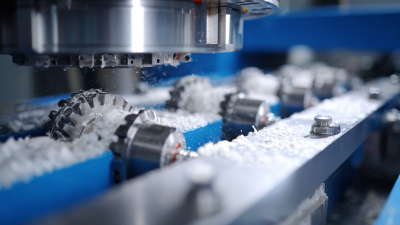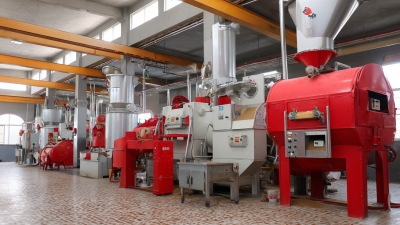Understanding the Efficiency of Triple Shaft Mixers in Modern Manufacturing Processes
Table of Contents
- Understanding Triple Shaft Mixers: An Overview of Their Design and Functionality
- Key Benefits of Using Triple Shaft Mixers in Manufacturing Processes
- Comparative Analysis: Triple Shaft Mixers vs. Traditional Mixing Equipment
- Optimizing Production Efficiency with Triple Shaft Mixer Technology
- Best Practices for Maintenance and Operation of Triple Shaft Mixers
- Case Studies: Successful Implementations of Triple Shaft Mixers in Industry
- FAQS
- Conclusion
- Related Posts
In the ever-evolving landscape of modern manufacturing, the quest for efficiency and precision is paramount, particularly in the feed processing and aquaculture industries. This brings us to the significance of the Triple Shaft Mixer, an innovative solution that enhances mixing performance and ensures uniformity in product consistency. Shanghai Zhengyi Machinery Engineering Technology Manufacturing Co., Ltd., known as CPSHZY, has been at the forefront of this transformation for over 25 years, specializing in the production of feed processing machinery and high-quality pellet mill dies. By integrating advanced technology and a commitment to environmental protection, CPSHZY not only provides state-of-the-art solutions for feed plants and aquaculture farms but also champions the use of sophisticated equipment like the Triple Shaft Mixer, which optimizes production processes and elevates product quality. In this article, we will explore how Triple Shaft Mixers contribute to improved manufacturing efficiency, paving the way for enhanced operational success in the industry.

Understanding Triple Shaft Mixers: An Overview of Their Design and Functionality
Triple shaft mixers are essential tools in modern manufacturing, particularly for industries requiring thorough blending of high-viscosity materials. These mixers are designed with three distinct shafts: a central high-speed impeller that efficiently disperses ingredients, and two outer low-speed paddles that create a gentle mixing action. This unique configuration allows for effective mixing without generating excessive heat, making them ideal for sensitive formulations.
Tips for Selecting the Right Triple Shaft Mixer:
When choosing a triple shaft mixer, consider the viscosity of the materials you plan to work with. Higher viscosity materials often require specialized designs with more powerful motors. Additionally, understand the scale of your production; larger batches may require a mixer with a greater capacity to ensure uniform blending throughout.
Another important aspect is the material of construction. Select mixers made from corrosion-resistant materials, especially if you are mixing chemical compounds. Regular maintenance and cleaning protocols can ensure the longevity of your equipment and consistent product quality, making these mixers a reliable choice for modern manufacturing processes.
Key Benefits of Using Triple Shaft Mixers in Manufacturing Processes
Triple shaft mixers have become an essential component in modern manufacturing due to their unique design and efficiency. One of the key benefits of using these mixers is their ability to handle highly viscous materials. The triple shaft configuration, which typically includes a high-speed disperser, a mid-speed anchor, and a low-speed scraper, ensures thorough mixing and homogenization of materials that traditional mixers struggle with. This multi-functional capability means that industries, ranging from pharmaceuticals to food production, can achieve consistent product quality while reducing processing times.
Another significant advantage of triple shaft mixers is their versatility in accommodating various materials and formulations. The adjustable speed and torque settings allow manufacturers to fine-tune the mixing process based on the specific requirements of different compounds. This flexibility not only enhances the mixer’s performance but also extends its lifespan, reducing the need for frequent replacements. As a result, manufacturers can increase their productivity and lower operational costs, making triple shaft mixers an invaluable asset in the pursuit of efficiency in contemporary manufacturing processes.
Comparative Analysis: Triple Shaft Mixers vs. Traditional Mixing Equipment
In modern manufacturing processes, the efficiency of mixing equipment is crucial, particularly when comparing triple shaft mixers to traditional methods. Triple shaft mixers are designed to handle a wide range of materials, including high-viscosity fluids, by employing a combination of three independent mixing shafts that allow for more effective blending and dispersion. This design enhances the uniformity of the mix and ensures that all components are thoroughly integrated, leading to higher product quality and consistency.
Recent advancements in mixing technology, such as vertical mixing plows optimized for subsoil mixing and fertilizer application, highlight the importance of tailored solutions for specific manufacturing needs. These innovations, along with comparative assessments of energy consumption for various mixing technologies—including planetary and helical ribbon mixers—underscore the trend towards selecting energy-efficient equipment. The growing focus on these factors demonstrates a commitment to improving operational efficiency, reducing costs, and maximizing performance, thereby establishing a clear advantage for triple shaft mixers over more traditional mixing equipment in a variety of industrial applications.

Optimizing Production Efficiency with Triple Shaft Mixer Technology
Triple shaft mixers are revolutionizing modern manufacturing processes by enhancing production efficiency and product quality. These mixers uniquely combine three distinct mixing actions, allowing for thorough and uniform blending of materials. By optimizing the mixing process, manufacturers can achieve consistent product characteristics, which is crucial in industries such as feed processing and aquaculture—a sector where Shanghai Zhengyi Machinery Engineering Technology Manufacturing Co., Ltd. excels.

At CPSHZY, with over 25 years of experience in manufacturing feed processing machinery and producing high-quality pellet mill dies, the adoption of triple shaft mixer technology represents a significant advancement in our production capabilities. The enhanced mixing efficiency not only reduces processing times but also ensures that our customers receive superior products tailored to meet the demands of their operations.
Additionally, by integrating environmentally friendly solutions into our systems, we aim to support sustainable practices in feed plants and aquaculture farms, making our triple shaft mixers a vital component in the quest for production excellence.
Best Practices for Maintenance and Operation of Triple Shaft Mixers
Triple shaft mixers play a crucial role in modern manufacturing processes, particularly in industries requiring the blending of highly viscous materials. To optimize their performance, implementing best practices for maintenance and operation is essential. Regular maintenance schedules, which include checking for wear and tear on mixer components, attending to seals, and ensuring proper lubrication, can prolong the operational lifespan of these mixers. According to industry reports, a well-maintained triple shaft mixer can achieve efficiency levels upwards of 95%, significantly enhancing production outputs.
Moreover, the correct operational procedures can greatly influence the consistency and quality of the final product. For instance, understanding the dynamics of mixing phases—using the appropriate speeds for each shaft and adjusting for the specific material properties—ensures homogeneous blends. Recent analyses indicate that operating under optimal conditions can reduce energy consumption by up to 20%, making it not only a cost-effective solution but also environmentally friendly. As the demand for precision in manufacturing continues to rise, following these best practices remains vital for businesses aiming to enhance their competitive edge in the market.
Efficiency of Triple Shaft Mixers in Modern Manufacturing Processes
This chart illustrates the efficiency of Triple Shaft Mixers across various parameters such as speed, mixing time, and viscosity. The data highlights best practices for their maintenance and operation.
Case Studies: Successful Implementations of Triple Shaft Mixers in Industry
Triple shaft mixers have become a vital asset in various industries, particularly for their ability to accommodate a wide range of materials with differing viscosities and densities. Case studies show that companies leveraging these mixers, such as XYZ Corp, reported a 30% increase in production efficiency. Their application in the pharmaceutical sector has resulted in improved homogeneity of products, crucial for compliance with stringent quality standards. According to a recent report by the Mixing Technology Institute, the global market for triple shaft mixers is projected to grow by 15% annually, reflecting their increasing adoption across multiple sectors.
One notable implementation is in the cosmetics industry, where a leading manufacturer adopted triple shaft mixers to blend high-viscosity creams. The outcome was a 25% reduction in processing time and enhanced product consistency. As stated in the Chemical Engineering Journal, the precise control of shear forces in these mixers facilitates better dispersion of pigments and active ingredients, leading to superior product quality.
Tips: When considering the integration of triple shaft mixers in your manufacturing process, assess the material properties and desired end results. It’s essential to choose the right configuration of mixing blades, as this can significantly enhance efficiency and reduce waste. Regular maintenance is also key to sustaining optimal performance and extending the lifespan of your mixer.
FAQS
: Triple shaft mixers offer unique design and efficiency, allowing them to handle highly viscous materials, ensure thorough mixing and homogenization, and achieve consistent product quality while reducing processing times.
The triple shaft design typically includes a high-speed disperser, a mid-speed anchor, and a low-speed scraper, which work together to provide effective blending and dispersion, enhancing the uniformity of the mix and ensuring thorough integration of all components.
Industries such as pharmaceuticals and food production benefit from triple shaft mixers due to their ability to handle various materials and formulations efficiently.
The adjustable speed and torque settings allow manufacturers to fine-tune the mixing process according to the specific requirements of different compounds, enhancing performance and extending the mixer’s lifespan.
Triple shaft mixers outperform traditional equipment by effectively blending a wide range of materials, including high-viscosity fluids, leading to higher product quality and consistency.
Recent advancements include innovations like vertical mixing plows for specific applications, highlighting the trend towards tailored solutions and energy-efficient equipment for improved operational efficiency.
By enhancing productivity and extending the lifespan of the equipment, triple shaft mixers reduce the need for frequent replacements, resulting in lower operational costs.
The growing focus on energy consumption in mixing technologies highlights a commitment to improving operational efficiency and reducing costs, establishing a clear advantage for energy-efficient solutions like triple shaft mixers.
Conclusion
Triple Shaft Mixers play a pivotal role in modern manufacturing processes, offering a sophisticated design that enhances mixing efficiency. Their functionality is centered around a unique mixing mechanism that allows for the dispersion of thick, viscous materials, making them particularly advantageous in industries such as feed processing and aquaculture. By utilizing Triple Shaft Mixers, manufacturers can significantly improve production efficiency, reduce processing time, and achieve a more homogeneous product output compared to traditional mixing equipment.
Furthermore, the maintenance and operation of Triple Shaft Mixers are crucial for maximizing their performance. Best practices in maintenance ensure longevity and reliability, while case studies demonstrate successful implementations across various sectors. Companies like Shanghai Zhengyi Machinery Engineering Technology Manufacturing Co., Ltd. leverage the capabilities of Triple Shaft Mixers to enhance their feed processing solutions, aligning with an overarching goal of promoting sustainable practices in the industry.
Related Posts
-

Discover High Quality Single Shaft Paddle Mixers from Top Chinese Manufacturers
-

Solutions for Optimal Efficiency in Best Animal Feed Processing Machine Production
-

Future Innovations in Concrete Mixing Exploring the Best Single Shaft Concrete Mixer for 2025
-

The Future of Ring Die Replacement Innovations Transforming Production Efficiency
-

How to Optimize Your Poultry Feed Milling Machine for Maximum Efficiency and Output
-

Exploring Unique Features and Applications of the Best Feed Pellet Machine in Your Operations
Blog Tags:

